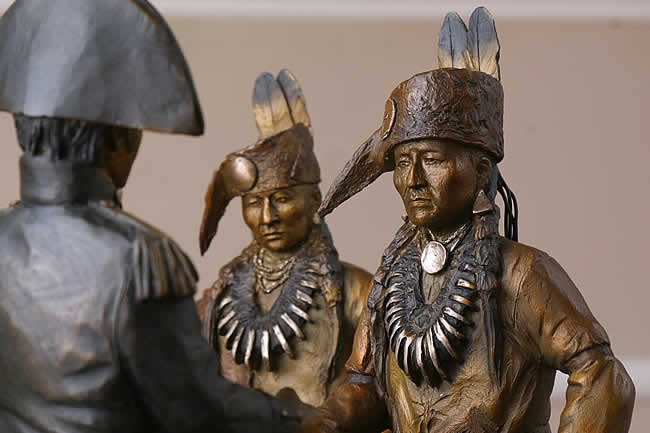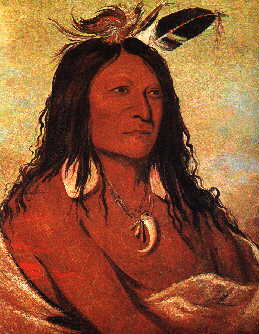|
July
31, 1763:
|
Captain
James Dalyell, and 280 soldiers attack Pontiac's village at
2:30 am this morning. Pontiac is informed of Dalyell's plans,
so he sets up an ambush at the Parent's Creek bridge with
400 Indians. When Dalyell's troops approach the bridge, the
Indians attack. Twenty soldiers, including Dalyell, and seven
Indians are killed in the fighting. The creek, near Detroit,
is now called Bloody Run. Major Robert Rogers helps Dalyell's
survivors to escape.
|
|
|
Aug
1, 1739:
|
Several
SHAWNEE Chiefs sign a peace treaty with British Pennsylvania
authorities not to become allies with any other country. The
British agree to enforce previous treaties banning the sale
of rum to the Indians.
|
|
|
Aug
2, 1792:
|
MOHEGAN
Samson Occom dies in New Stockbridge, New York. A protégé
of Rev. Eleazar Wheelock, Occom learns numerous foreign languages,
become an ordained minister, be the first Indian to preach
in England, minister to many Indian tribes, and be instrumental
in the establishment of Dartmouth College in New Hampshire.
|
|
|
|
|
The
two Native Americans represent the Oto and Missouria
Tribes who participated in the council. Input was received
from Tribal representatives to assure accuracy in their
depiction. (From the Lewis & Clark Council Bluff
Interpretive Monument)
|
|
|
Aug
3, 1804:
|
Lewis
and Clark held a conference with chiefs of the OTO and MISSOURI
and presented them with medals.
|
|
|
Aug
4, 1813:
|
500
warriors of the White Stick faction of the CREEKs gather in
Coweta, across the river in Alabama from modern Columbus Georgia.
With 200 CHEROKEE warriors, they make plans to attack a band
of Red Stick CREEKs, followers of Tecumseh, over 2,500 strong.
The White Sticks are led by Tustunnuggee Thlucco and Tustunnuggee
Hopoie.
|
|
|
Aug
5, 1570:
|
A
Spanish colony expedition in sailing up the Chesapeake in
Virginia, when they reach the area they will call Axaca somewhere
near the Rappahannock. The local Indians will force the Spanish
to abandon the effort.
|
|
|
|
|
A Comanche named Bow and Quiver. Painted by George Catlin in 1832
|
|
|
|
Aug
6, 1840:
|
Hundreds
of COMANCHEs, led by Buffalo Hump, surround, and attack Victoria,
Texas. In the next two days, fifteen settlers are killed in
the fighting. The COMANCHEs take several hundred head of livestock.
|
|
|
Aug
7, 1670:
|
APACHE
or NAVAJOs attack the ancient ZUNI Pueblo of Hawikuh. They
burn the church, and kill the resident missionary.
|
|
|
Aug
8, 1699:
|
The
TOHOME Indians live along the Gulf Coast in Alabama and Mississippi.
In Biloxi, they formally establish peaceful relations with
the French.
|
|
|

Timpoochee
Barnard, another Euchee from Georgia. A McKenney-Hall portrait.
|
|
Aug
9, 1814:
|
The
Treaty of Fort Jackson (7 stat.120) officially ends the CREEK
War. The CREEKs, including those who fought with Andrew Jackson,
are forced to cede 22,000,000 acres, almost half their lands,
to the United States. Timpoochee Barnard, one of the YUCHI
Indian allies of the Americans, is one of the signatories
to the treaty of Fort Jackson. Fort Jackson, formerly Fort
Toulouse, is in modern Wetumpka, Alabama.
|
|
|
Aug
10, 1680:
|
The
PUEBLO Rebellion takes place in New Mexico under the leadership
of a Tewa named Popé. Popé has arranged for
an attack on as many of the Spanish missions as possible to
all take place on the same day. Some sources say this happens
on August 11th.
|
|
|
Aug
11, 1802:
|
Tecumseh
has predicted an earthquake. It happen and becomes known as
the "New Madrid Earthquake."
|
|
|
Aug
12, 1769:
|
KUMEYAAY
Indians fight with the Spaniards who have established the
Mission San Diego de Alcala in what becomes San Diego, California.
|
|
|
Aug
13, 1645:
|
For
several years, the Dutch, and the local Indian tribes near
New Amsterdam and Pavonia, have been fighting. HACKENSACK
Chief Oratamin negotiates a peace between the warring parties.
It is another ten years before another major conflict erupted.
|
|
|
|
|
|

|
|
|
|
|
    
|
|
    
|
|
|
|
| |

|
|
| |
Canku Ota is a free Newsletter celebrating Native
America, its traditions and accomplishments . We do not provide subscriber
or visitor names to anyone. Some articles presented in Canku Ota may
contain copyright material. We have received appropriate permissions
for republishing any articles. Material appearing here is distributed
without profit or monetary gain to those who have expressed an interest.
This is in accordance with Title 17 U.S.C. Section 107. |
|
|
|
|
| |
Canku Ota is a copyright © 2000,
2001, 2002, 2003, 2004 of Vicki Barry and Paul Barry.
|
|
 |
|
 |
|
The "Canku Ota -
A Newsletter Celebrating Native America" web site and its design
is the
|
|
Copyright ©
1999, 2000, 2001, 2002, 2003, 2004 of Paul C. Barry.
|
|
All Rights Reserved.
|
|




